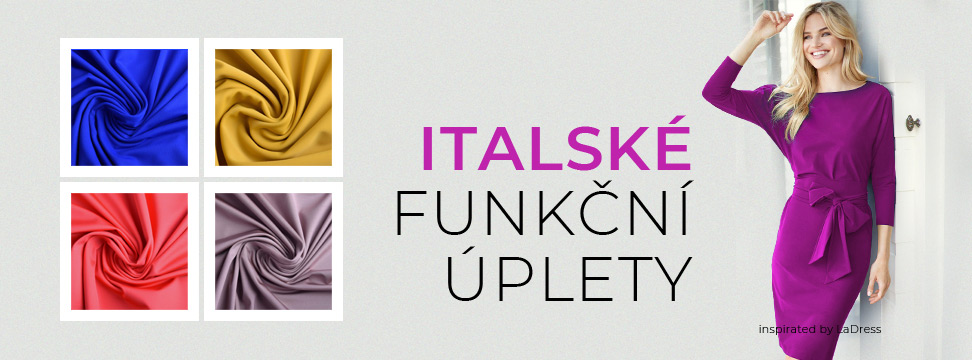Functional knitwear for sports and social wear
Imagine that there is a clothing material in which you can go for a run and you can also make an elegant party dress or light underwear from it.
Don't you believe? But yes, it's true. Such a small revolution in dressing, when one material is the absolute top of the field in its versatility and is suitable for sewing different pieces of clothing into your new wardrobe.

A little history of swimwear/functional knitwear
According to the discovered wall paintings , swimsuits were already known in ancient times in Pompeii, and two-piece swimsuits were used for athletic purposes in ancient Greece around 1400 BC. bathing.
The first bathing suit began to be worn in the 18th century, which rather resembled long bathrobes. The bathrobe was a long dress made of opaque material with long, sewn-on pants, which have nothing to do with today's swimwear. The development of swimwear shifted in the 19th century, and knee-length bathrobes with ankle-length trousers were already being worn at that time.
From 1906, mannequins began to appear in sleeveless swimsuits , with pants only halfway up the thighs and with bare shoulders. In the 1930s, swimwear fashion progressed and revealed not only the shoulders, but also the back. In 1946, a bikini appeared for the first time at a fashion show in Paris, rewriting the history of swimwear . Since then, various adaptations have been constantly appearing, but nothing has yet equaled the popularity of the bikini.
Nowadays, it is mostly looked at whether the swimsuit has a refined cut that can mask all the flaws. They have to meet a variety of patterns, fashionable colors and decorations.
Italian functional knitwear
Women love this Italian quality for many reasons.
The elastic fiber gives the functional knitwear high elasticity in both directions and this means that the knitwear is flexible , soft on the skin and very breathable at the same time.
When stretched or wrapped around the body, it keeps its shape , does not stretch or shrink . This timeless functional material is suitable for any occasion. Whether you follow a sporty style of clothing or an elegant outfit.
The transparency of the stretched knit depends on its individual weights . The heavier the weight , the less the knit will show through , ideal for leggings and tight sports shirts and tops . On the contrary, the smaller the weight , the more transparent and airy the knit will be, which you can use for delicate, flowing clothes.
Functional knitwear is very simple and practical to maintain. After washing, it dries quickly , does not iron , does not pill , the colors maintain their stability . That's why this material is also sometimes called Travel .
What to sew from functional knitwear
It is suitable for sports t-shirts, leggings, swimwear, dance and sports jerseys , because if you sweat during physical activity, the material will wick away the sweat and you will remain comfortably dry and comfortable. Or you can use it to make a colorful party dress for more festive occasions.
The hit of recent years is seamless body underwear with a sewn-in cotton gusset, which perfectly adapts to the body, is very comfortable , does not press and does not draw under clothes.
How to sew elastic knit
A huge advantage of functional knitwear is that it does not fray when sewn, so no special sewing machine is needed. If you are sewing a functional knit on a classic sewing machine, choose an elastic stitch or zigzag .
When sewing, we recommend reaching for a stretch needle . You avoid the appearance of unsightly cut holes that appear when the seam is stretched.
A selection of similar materials with swimwear/functional knitwear
Swimwear is a unique material that is extremely flexible and resistant to water and sun. When choosing additional materials, it is therefore important to take into account its characteristics.
Similarity with other materials
In terms of colors, swimwear is one of the most versatile materials. Thanks to its high color fastness, the swimsuit can be combined with a wide range of colors. Its ability to retain its color even when exposed to sun and water means it is ideal for combining with other durable materials such as nylon or polyester.
In terms of textures , swimwear is generally smooth and shiny, which can blend well with other smooth and shiny materials. However, contrasting textures such as coarse cotton or ruffles can create an attractive visual difference.
The surface finish of the swimwear can also affect its use with other materials. For example, a matte swimsuit may be suitable for combining with other matte materials, while a shiny swimsuit may complement other shiny materials such as satin or silk .
Production and processing of swimwear
Swimwear is a really interesting material when it comes to its production and processing. From the raw materials used to the manufacturing processes and quality control, every step contributes to the exceptional properties of this material.
Raw materials for production
Swimwear is a synthetic material , usually made of polyester or nylon, often combined with elastane to increase elasticity. These raw materials are derived from oil, which is a non-renewable resource. In recent years, however, recycling has been developing significantly in the area of the textile industry. Recycled swimwear, which is made from waste materials such as old fishing nets or plastic bottles, is becoming increasingly popular due to its eco-friendly profile.
Manufacturing process
Swimwear production usually involves a knitwear process , during which fibers, often with added elastane, are woven into a thin and flexible fabric. Weaving is less common because it does not have the flexibility of knitting, which is necessary to produce comfortable and well-fitting swimwear.
This online store stores cookies that help it function properly. By using our services, you agree to their use.